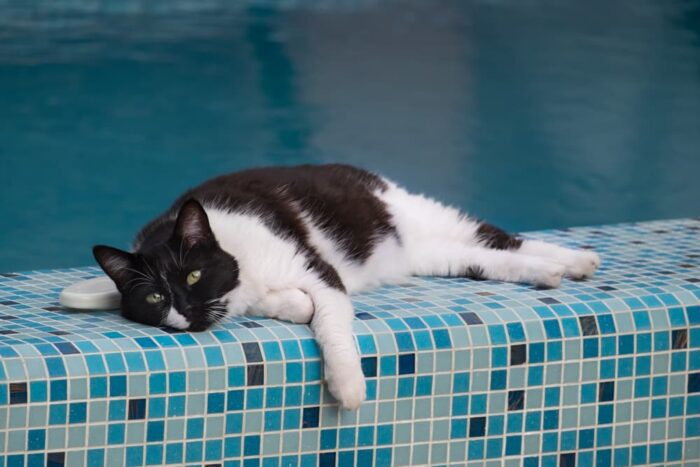Watching YouTube’s endless stream of sensory-seeking cats tentatively pawing at water raises a common question–can cats swim at all? Understanding key physical attributes, inherited instincts, and training considerations surrounding water sheds light on true feline aquatic aptitude. In this post we talk about Can Cats Swim.
The Cold Hard Facts on Cat Swimming
When it comes to basic water skills, cats significantly trail their canine counterparts regarding natural aquatic agility. Unlike retrievers joyfully bounding after tennis balls afield, most kitties remain perpetual wallflowers clinging safely to dry land rather than diving in themselves.
Heightened wariness stems from retaining largely desert-dwelling evolutionary roots as opposed to swimming predators like otters. For cats, entering water signals exposure and vulnerability rather than opportunity. Moreover, lean feline bodies prone to rapid heat loss lack insulating fat keeping other mammals buoyant, further discouraging aqueous activities. Thin fur coats also quickly saturate weighing cats down mid-paddle.
So while rare ambitious felines eventually tackle swimming sufficient for self-rescue, full fluid coordination generally remains unlikely. Their bodies simply didn’t develop adapting robust aquatic survival abilities like more water-dependent species. These differences explain many wet cats scrambling rather ungracefully to exit ASAP.
Built-In Buoyancy Basics
However, while clumsy technicians, all healthy cats do retain sufficient basic survival swimming capacity should accidental falls or floods occur. Lightweight skeletal structures combined with air pockets around lungs enable brief bouts staying afloat.
This grants opportunity either pulling themselves back aboard overturned vessels in open waters or buying precious minutes awaiting rescue flailing toward perceived safety. Adrenaline certainly assists mustering temporary marathon feats too! So cats displaying disinterest around routine baths still hold some latent paddling skills when water transports life or death outcome urgency.
Breed & Body Effects
Certain cat conformations fare better facing unplanned dips as well. Namely athletic lean breeds like Turkish Vans showcasing webbed paws take naturally to buoyancy basics. Long-bodied Bengals also leverage extra sinew and flexibility cutting through water more efficiently.
By contrast, dense broad-chested Maine Coons and flattened Persian faces struggle emergency swimming despite lengthy fur and abundant padding. Pre-existing respiratory issues compound complications too. Because fur rapidly weighs down even Burmese cat Olympic hopefuls over time, all felines progressively lose whatever fleeting power kick initially launched their desperate crawl stroke past grabbed tree branches or boat gunnels.
Improving Confidence Around Water
While cats likely never achieveexpert human levels of fluid coordinated strokes, some training tactics assist improving acclimation and self-rescue reflexes critical for safety. Early positive exposure helps kittens especially develop trust and capability faster.
Helping fearful felines gradually gain confidence working up to basic submersion and providing secure exits allows feelings of control. This further motivates engagement accepting water play as enrichment rather than antagonistic torture. Favorite treats tossed in encouraging paw dunking reward curiosity conquering instinctive hesitancy too.
In worst case flooding hazards, simply securing light life jackets boosts cats’ odds swimming sturdily. Just ensure plenty collar/harness strapping because squirming soon dislodges paraphernalia otherwise! Even dogs struggle here. Also confirm adequate flotation capacity supporting multiple minutes waiting on backup. Better overly prepared than sadly sunk.
Emergency Preparedness Keys
Regardless swimming prowess polish, always approach aquatic activities insightfully. Even water-friendly cats remain ill-equipped handling risky situations solo relative other species. Safety preparations minimize preventable catastrophe risks.
● Accompany cats outdoors near waterways ensuring reliable prompt recall when called
● Refrain leaving unattended near chlorinated pools due to falling/drowning risks
● Check boating regulations in your area regarding pets onboard and integrated flotation protocol
● Have feline-approved life jackets handy sailing with cats in case they go overboard
● Know appropriate rescue breathing technique reviving near-drowned cats
● Maintain first aid knowledge treating hypothermia, aspiration pneumonia and burn management
While cats not named “Phelps” or “Lochte” any time soon, decent odds exist coasting through shallow immersions or self-rescuing near floating structures with preparation. Understanding innate skills, disabilities, and needed back up protocols keeps both owner and cats safely afloat! Then go ahead sprinkling in tactically laced water play for enriched curiosity and skill stretches summing survival necessities. I hope this Can Cats Swim post helps you.

Dr. Katie Lawlor is a seasoned expert in pet care with over 8 years of experience dedicated to enhancing the well-being of pets and their families. As a passionate advocate for animal health, Dr. Lawlor combines her extensive knowledge with a compassionate approach, offering valuable insights and practical advice on pet wellness. Her commitment to improving the lives of pets and their owners is reflected in her engaging content on PetPawsitively .com. Follow Dr. Lawlor’s work and connect with her on Instagram for expert tips and support.





